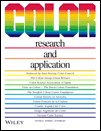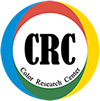
Chanprapha Phuangsuwan and Mitsuo Ikeda
Col. Res. and Appl. 2017; vol.42 Issue 5. pp.571-579.
abstract
The state of chromatic adaptation was investigated by using the two-room technique. This technique involves a subject in a room who looks a white board in a separate test room through a window and judges the color of the window using the elementary color naming method. When the subject room is illuminated with a colored light and the test room with a white light, the window appears to be a very vivid color, for which the apparent hue depends on the color of the subject room. The color is referred to as the adapted color. The subject also evaluated the appearance of the illumination color of the subject room, which is called the adapting color. Two types of illuminating light in the subject room, fluorescent lamps with 7 colors and LED lamps with 19 colors, were employed. The adapting and the adapted colors were plotted on a polar diagram that was used in the opponent color theory, from which the hue angles were obtained. The hue angle difference between the two colors did not appear to be 180° except for one pair of adapting and the adapted colors, which implies that chromatic adaptation does not follow the opponent color concept. An improvement was achieved to explain the results by introducing complementary colors relation between the adapting and adapted color.
